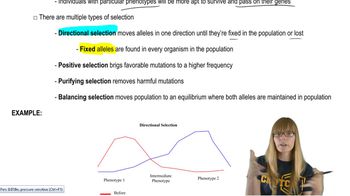Here are the essential concepts you must grasp in order to answer the question correctly.
Genotype and Alleles
A genotype refers to the genetic constitution of an organism, specifically the alleles present at a given locus. In this case, the alleles F and S represent different versions of a gene that encodes a detoxification enzyme. Understanding how these alleles interact to form genotypes (FF, FS, SS) is crucial for analyzing their fitness in the context of natural selection.
Recommended video:
New Alleles and Migration
Relative Fitness
Relative fitness is a measure of the reproductive success of a genotype compared to others in the population. It indicates how well a genotype can survive and reproduce in a given environment. In this scenario, the relative fitness values (0.72 for FF, 1.00 for FS, and 0.45 for SS) help determine which genotypes are more advantageous in agricultural fields treated with herbicides.
Recommended video:
Hardy-Weinberg Equilibrium
The Hardy-Weinberg equilibrium is a principle that describes the genetic variation in a population that remains constant from one generation to the next in the absence of evolutionary influences. It provides a mathematical framework to calculate allele frequencies based on genotype frequencies. In this question, it can be applied to find the equilibrium frequencies of alleles F and S based on their relative fitness values.
Recommended video:






